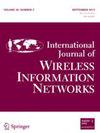Performance Analysis of a Decode-and-forward based Mixed RF-FSO-VLC System
IF 1.2
Q3 TELECOMMUNICATIONS
International Journal of Wireless Information Networks
Pub Date : 2022-01-25
DOI:10.21203/rs.3.rs-1288723/v1
引用次数: 0
Abstract
In this paper, the performance analysis of a cooperative radio frequency-free space optical communication-visible-light-communication (RF- FSO - VLC ) system using decode-and-forward ( DF ) relays is presented. In the proposed model, the RF link acts as the core network, the FSO link is used for providing last mile connectivity for the indoor cell users communicating through VLC environment. The RF link is characterized by Nakagami - $m$ -distributed fading, while the FSO link undergoes Double Generalized Gamma ( DGG ) distributed atmospheric turbulence and pointing errors and the VLC link is characterized by the Lambertian pattern of the LED. The closed-form expressions of the statistical characteristics of signal-to-noise-ratio ( SNR ) of the DF based triple-hop system are evaluated using which various performance metrics, i.e, outage probability, bit error rate ( BER ), and capacity of the considered system are obtained. The numerical results show that the system's performance gets severely affected by the RF fading, atmospheric turbulence, and pointing errors. The outage performance of the system decreases as field-of-view ( FOV ) and the height of the light-emitting-diode (LED) increase. It is also seen from the results that the BER performance of the system is better in case of heterodyne detection as compared to direct-detection. It is also observed that the capacity of the system decreases when the effect of atmospheric turbulence and pointing error is high and it increases when the no. of LEDs increases.一种基于解码和前向的混合RF-FSO-VLC系统的性能分析
本文介绍了一种使用解码转发(DF)中继的协作射频自由空间光通信可见光通信(RF-FSO-VLC)系统的性能分析。在所提出的模型中,RF链路充当核心网络,FSO链路用于为通过VLC环境通信的室内小区用户提供最后一英里连接。RF链路的特征是Nakagami-$m$-分布式衰落,而FSO链路经历双广义伽马(DGG)分布式大气湍流和指向误差,VLC链路的特征在于LED的朗伯模式。评估了基于DF的三跳系统的信噪比(SNR)统计特性的闭合表达式,使用该表达式可以获得所考虑系统的各种性能指标,即中断概率、误码率(BER)和容量。数值结果表明,系统的性能受到射频衰落、大气湍流和指向误差的严重影响。系统的断电性能随着视场(FOV)和发光二极管(LED)高度的增加而降低。从结果中还可以看出,与直接检测相比,在外差检测的情况下,该系统的BER性能更好。还观察到,当大气湍流和指向误差的影响高时,系统的容量降低,而当LED的数量增加时,系统的能力增加。
本文章由计算机程序翻译,如有差异,请以英文原文为准。
求助全文
约1分钟内获得全文
求助全文
来源期刊

International Journal of Wireless Information Networks
TELECOMMUNICATIONS-
CiteScore
6.60
自引率
8.00%
发文量
41
期刊介绍:
International Journal of Wireless Information Networks is an international forum for the dissemination of knowledge related to wireless information networks for researchers in the telecommunications and computer industries. This outstanding quarterly publishes high-quality, peer-reviewed original papers on applications such as sensor and mobile ad-hoc networks, wireless personal area networks, wireless LANs, mobile data networks, location aware networks and services, and RF localization and RFID techniques. The journal also covers performance-predictions methodologies, radio propagation studies, modulation and coding, multiple access methods, security and privacy considerations, antenna and RF subsystems, VLSI and ASIC design, experimental trials, traffic and frequency management, and network signaling and architecture.
Four categories of papers are published: invited openings (review current and future directions), overview reports (address the philosophy and technical details of the standards and field trials), technical papers (present specific technical contributions of archival value), and letters (present new enhancement of previously published works, statements of open problems, comments on published papers, and corrections). International Journal of Wireless Information Networks aims to fill the needs of academic researchers involved in basic research at universities or research laboratories; telecommunications and computer engineers involved in design, planning, operation, and maintenance of state-of-the-art wireless information networks; and the technical community in telecommunications and computers involved in applied research and standards activities.
To view cumulative tables of contents, find details on the latest call for papers, or other information, please visit the http://www.cwins.wpi.edu/journal.html International Journal of Wireless Information Networks Web Site.
 求助内容:
求助内容: 应助结果提醒方式:
应助结果提醒方式:


